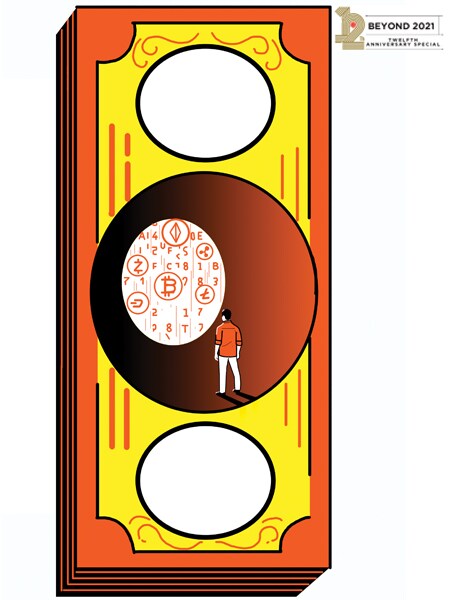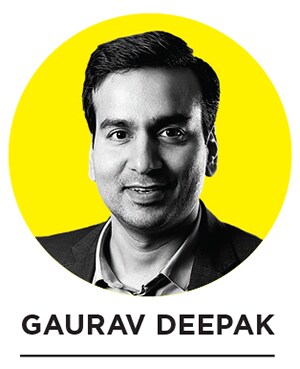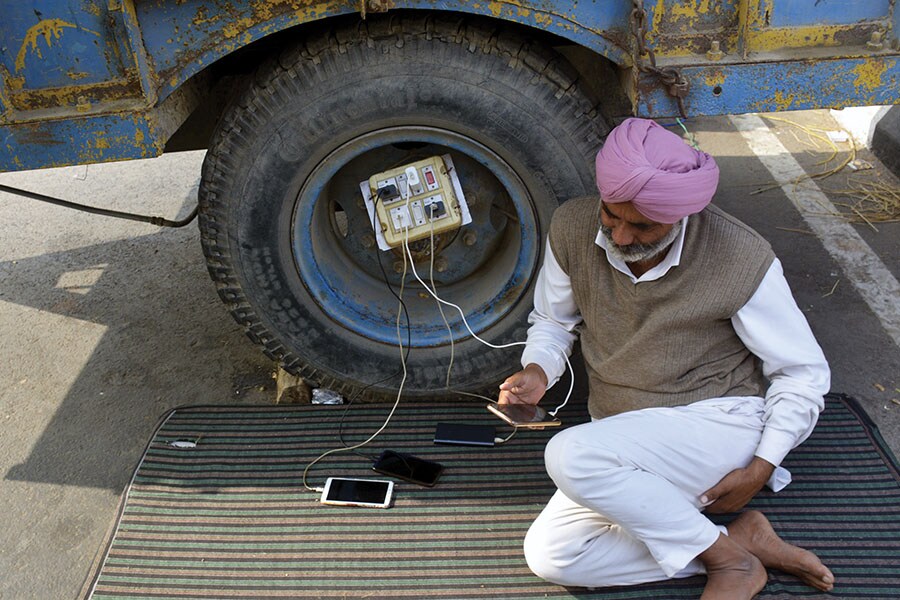e will see a strong jump in value creation in India in this decade, an almost 200 percent increase. In the decade of 2001-10, we saw an incremental value creation of about $1 trillion and a similar number in the decade of 2011-20. This created a market cap of around $2.5-2.7 trillion, combining both public and private markets by end of 2020. In my estimate, we will end the current decade at a market capitalisation of $7.5-8 trillion, which implies an incremental value creation of $5 trillion, which is five times the previous two decades.
I believe that this value will be driven by three key forces: Digital, large-scale manufacturing and sustainability.
I want to focus on digital here. I believe that 50 percent of the incremental value creation will be driven by digital and digital business models, which will account for 30 percent of the total value of the market that we will see at the end of this decade. This number stands at approximately 10 percent today.
In the first wave of digitalisation, we saw digital largely around B2C commerce, travel, entertainment, payments (started with wallets), ride sharing, car and financial products and marketplaces. We also saw deep penetration in urban and semi-urban areas where families have adopted digital in daily lives. In this evolution of digital, the first few years was all about data and content consumption, then about discount hunting leading eventually to pay for service, quality and convenience. Our estimate of digital-first families in India is approximately 10 million, which is less than 3 percent of the families in India. And digital-first businesses you can count by name, with most of them being native digital. Traditional businesses still have not changed their models to become digital-first businesses. Once they do, the digital game will climb into a different orbit.
You are all aware that Covid has deeply accelerated digital adoption not only in India, but in the world. This has led to two core fallouts. One is that families and businesses have started adopting digital faster and deeper in their daily lives two, entrepreneurs have started innovating products like never before. The products and services we use today were mostly conceptualised pre-pandemic, but you will now begin to see a full flow over the next 12 months of new innovation that was driven by the large-scale adoption of digital during the pandemic.
![]() A farmer charging his phone at a jerry-rigged charging station during protests near Ghazipur, in Ghaziabad. Traditional businesses in agriculture are leveraging digital native businesses to aggregate village-level produce to ensure farmers get the best price
A farmer charging his phone at a jerry-rigged charging station during protests near Ghazipur, in Ghaziabad. Traditional businesses in agriculture are leveraging digital native businesses to aggregate village-level produce to ensure farmers get the best price
Image: Sakib Ali / Hindustan Times via Getty Images
The fact that families, businesses and communities are getting comfortable with digital, and the overall telecom penetration levels, will lead to a deeper digital penetration over the next five to 10 years. Let me give you a few examples. Pre-pandemic, the role of digital education was minimal in the Indian context.
The pandemic has upped the quality of education products, driven by marketplaces, quality tutors, and technology being available on the fingertips of everyone, irrespective of where you are. Vernacular has received a huge leg up as well. I expect digital learning to become the mainstay of learning, instead of just supporting traditional learning. This is truer in place where we don’t have good quality teaching infrastructure and teachers. I would see this as driving high-quality literacy in India.
Similarly, another area that has undergone a sea change is health care. We all know that the infrastructure and trained doctors to provide quality health care at scale in this country are still lacking. But several corporates and governments are now trying to make headway. I would see this transforming, driven by digital across pharmacies, doctor consultations, telemedicine and diagnostics, both for preventive and curative health care. The entire data that is being generated can be used to create far better and cheaper outcomes for consumers across India, not only those in the large metros.
We are seeing a big change around supply chains being digitalised. This world has been traditionally driven by incremental innovation, rather than rethinking how to drive outcomes very differently. So let me give an example. To go from point A to point D, we traditionally would go from A to B, B to C and C to D, and we spent decades fine-tuning A, B and C. What we are seeing today is a situation where the new-age entrepreneurs are focusing on outcome D, while the starting point and the path could be anything. This allows for significant efficiencies in the supply chain, and these are being shared with the customers, making the overall business more efficient.
Two examples, among others, jump out at me—Infra.Market and Ofbusiness. Both have created, over the last couple of years, half a billion to a billion-dollar supply chain businesses, and yes profitable ones at that. They are creating differentiated business models using digital data and innovating in industries which are steeped in tradition and incremental thinking.
undefined50 percent of incremental value creation will be driven by digital It will account for 30 percent of the total value of the market[/bq]
The other area that will see massive impact of digital will be ‘Bharat’. Here you will see maximum innovation that will be India-led innovation. It is also an area that will have maximum impact from our country perspective. You will see deep innovation in areas like agriculture, commerce, health care, education and others. In the post Covid-19 era, traditional businesses in FMCG, agriculture are leveraging the digital native businesses to address their broken supply chains—whether it is illuminating the last-mile, data-dark kirana shop in an upcountry market, using city / town level entrepreneurs to increase distribution of not-so-well-known local brands, or aggregating village-level produce to ensure farmers get the best price and consumers also win due to disruption of the middle-men network, digital-first businesses are transforming Bharat. Three examples will illustrate the point. ElasticRun is revolutionising last-mile kirana shops in upcountry markets. DealShare is using thousands of micro-entrepreneurs and a social platform to sell high frequency daily items to millions of consumers and DeHaat is making sure that both supply side and demand side supply chain for farmers is well-oiled and transparent.
Another area which will have deep impact will be financial services. We have already seen rapid change in the payment landscape driven by UPI. India is at the global forefront in payment systems even though it is a country of significant complexity and heterogeneity. This is accentuated by the need to provide solutions at very low costs to account for lower ticket sizes. We have not seen digital making a dent yet in core financial services such as lending. Early experiments here have not borne much result.
The players in fintech have learnt from the mistakes and are super focussed on confluence of acquisition-underwriting-collection. Banks are increasingly willing to partner with fintech players and more and more co-option models are emerging. In insurance, online distribution through Policybazaar, has become the biggest channel of distribution, with high quality customer base for many insurers. Availability of data is enabling digital insurance manufacturers such as Acko to underwrite far more smartly than through traditional means. The government and industry initiatives such as OCEN (Open Credit Enablement Network) and DEPA (Data Empowerment and Protection Architecture) are enabling the commoditisation of data for superior underwriting by banks, fintech players and NBFCs, benefitting the consumer and increasing credit penetration.
Leveraging data will also be relevant to a lot of other areas, including health care, education supply chain and a host of others, not just at the firm level, but also at the community and country level. It is my hope at this point in time that in areas like health care, we can leverage data to make this country far more efficient, which is what the government is trying to do through health care IDs.
Let us now talk about another sector that is ripe for value creation in our country. Compared to the global average of approximately 8 percent, the logistics cost in India stands at about 14 percent of GDP (about $400 billion).
This presents a massive opportunity for players to address the competitiveness gap of about $180 billion (about $500 billion by 2030). After having seen early adoption of RFIDs, GPS and IoT devices, Indian players are now transforming in line with global peers to adopt Industry 4.0 trends, based on artificial intelligence (AI), robotics and blockchain to build agile, high-visibility, resilient and green networks.
We expect continuous digitisation of front-end technology, increasing direct access to customer and tech-enabled efficiency increase to drive the boom in logistics in India.
These private initiatives are supported by strong policy initiatives and investments, aimed at optimisation of modal-mix, omnichannel distribution and high-quality core infrastructure. Central government-sponsored infrastructure investments are aimed at boosting hinterland connectivity (DFCs, Bharatmala, Sagarmala), world-class storage (MMLPs, FTWZs, Industrial corridors), and port-modernisation, further aided by domestic manufacturing schemes (Make in India, PLI schemes). DFIs, SWFs and PFs will continue to be active capital providers in the logistics sector, wherein 100 percent foreign direct investment (FDI) is permitted through automatic route.
Moving on, we would see a complete change in how we look at mobility in the coming decade, driven by shared mobility and electric vehicles (EV). A move towards electric vehicles is an integral step for sustainable long-term economic development of India.
India has the fourth largest automobile market in the world, which if fully electrified represents a market opportunity of over $200 billion. Electrification will provide energy security to the country by reducing the oil import bill (over $120 billion in FY20). India has already started its move towards an electrified future, and it stands to benefit from abundance of renewable energy sources and availability of skilled manpower in technology and manufacturing sectors.
By 2030, in a moderate EV adoption scenario, the EV ecosystem in India will present a revenue opportunity of $50-100 billion spread across various segments like OEMs, battery and other components, charging infrastructure and e-mobility services. This is a classic example of how there is opportunity for success by doing good.
Transaction sizes in India are among the lowest in the world and the customer demands exceptional outcomes even at these ticket sizes. The Indian entrepreneur has innovated very deeply, both in products and processes, to deliver these outcomes and still generate good economic margins. I think it is these innovations that will make many companies regional or global market leaders.
You can see that I am biased around the role of digital in driving outcomes for the people and this country. I believe in a decade you will see about 150 million digital-first families in India, which is almost half the Indian population. And most of the market leaders in their respective areas would be either digital-first or native digital businesses or businesses that have adopted digital as a core ethos.
The next decade of value creation will be an exhilarating journey. It will bring smart minds together to solve problems and to present solutions that we can’t even dream of today. Let’s get ready for the ride!
â— The writer is the co-founder and CEO of Avendus Capital



 A farmer charging his phone at a jerry-rigged charging station during protests near Ghazipur, in Ghaziabad. Traditional businesses in agriculture are leveraging digital native businesses to aggregate village-level produce to ensure farmers get the best price
A farmer charging his phone at a jerry-rigged charging station during protests near Ghazipur, in Ghaziabad. Traditional businesses in agriculture are leveraging digital native businesses to aggregate village-level produce to ensure farmers get the best price
